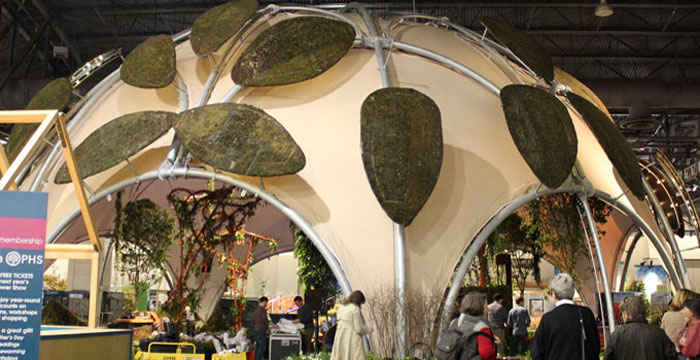
4 Big Green Lessons that Philly Can Learn from the Netherlands
The flower show this year was themed, “Holland: Flowering the World,” celebrating Dutch culture with wooden shoes, tulips, bikes, and windmills. Beyond the stereotypes, the exhibits also paid homage to the Netherlands’ environmental innovation and technology.
To honor the Netherlands rank as #11 in the Environmental Performance Index, the Flower show even had an eco dome as one of the show’s focal points. Transported from Holland and reassembled right here in Philadelphia, we can learn about the areas of sustainability where the Dutch excel.
4 Sustainability Lessons Transported from Holland
-
Integrating New Green Technology
The eco-dome featured vertical moss gardens, porous floors for drainage, a water collection system, and an enormous windmill. With its eco-friendly features and exhibits on new techniques like hydroponics and use of coconuts as renewable materials, the dome embodied the Dutch culture of environmental innovation.
A relatively new and exciting technology was the cement that absorbs carbon dioxide. Concrete is everywhere – our buildings, bridges, and sidewalks – but the key to concrete production, cement, has a huge carbon footprint. Cement production is the third largest source of greenhouse gasses in the U.S., and worldwide, 4 billion tons of cement are produced each year.
A more eco-friendly way could have a massive impact. The technique works by tweaking production techniques so that carbon dioxide is sequestered in the cement. The process is similar to the way corals build their reefs. Using water and waste heat, carbon dioxide is converted into carbonic acid and then makes carbonate. This flips the problem of emissions on its head by incorporating the storage of carbon dioxide into a useful product instead of letting it go in the form of emissions.
-
Windmills
The windmill on the front of the eco-dome may have just been a symbolic decoration (I imagine having an operational windmill of that size inside the convention center was not feasible for a multitude of reasons), but it alludes to the long history of wind energy in the Netherlands.
As one of the most iconic images of the Netherlands (just ask Don Quixote), windmills historically had many uses including processing raw materials like grinding grain or sawing logs. But for the low-lying country of Holland, they pumped water to drain lowlands so the land could be farmed. Areas of land that the Dutch reclaimed from the sea by draining peat bogs are known as polders. Fun fact: There’s actually a Dutch saying referring to this reclaiming of land that goes, “While God created the Earth, the Dutch created the Netherlands.”
Today, the country is now home to over 2,200 wind turbines. Recently, the Dutch railway network struck a deal with and energy company called Eneco to power all of its trains with electricity generated from wind turbines, as part of a national initiative to have 16% of the country’s energy come from sustainable sources by 2023.
-
Bicycles
Amsterdam and Copenhagen go back and forth for the title of “Bicycle capital of the world,” but the Dutch love their bikes.
Don’t believe me? Check out these statistics (from the flower show): the Netherlands has a population of 12 million people and 23 million bikes, Dutch people bike an average of 1.8 miles per day, and the country has 21,748 miles of bike paths. Not bad Holland, not bad.
Consider all the greenhouse gas emissions saved when people bike to work instead of taking cars. This impressive bike-utopia happened because of their commitment to bike friendly policy, laws, and infrastructure as a safe and efficient form of transportation. In fact, in cities like Amsterdam biking is generally more efficient than commuting by car. Buy hey, a few years and infrastructure tweaks and maybe Philly can give Amsterdam and Copenhagen a run for their money in the race to be the bike capital of the world. (Hint hint!)
-
Agriculture
The history of tulips in the Netherlands points to the country’s prominence in agricultural production and innovation. The Netherlands is second only to the U.S. as the world’s largest exporter of agricultural products and is the #1 exporter of flowers in the world (tulips being the most exported flower).
Tulips originated in central Asia and were first brought to Holland in 1593 when famous botanist, Carolus Clusius, became the director of the botanical garden at the University of Leiden, where he planted the tulip bulb he’d brought with him from Vienna. “Tulipmania” never actually did die out. Today, about 3 billion tulip bulbs are planted annually in the Netherlands.
Pretty impressive considering the country is only about 16,000 square miles and closest in size to the state of Maryland (at a little over 12,000 square miles). But it is precisely because the country is small that the Dutch developed such efficient farms.
In biotechnology, the Dutch are leaders in plant breeding due to their history of experimenting genetics, crossbreeding, and using tissue cultures. An estimated 70% of vegetables grown in the U.S. owe their genetics to the Dutch.
New varieties of plants are created each year in the Netherlands. Understanding the genetics of crops is only growing more crucial as climate change threatens traditional types and how we can make processes like agriculture more efficient and sustainable for the environment.
Other fascinating areas of innovation in Dutch agriculture the growth of multifunctional agriculture, energy neutral greenhouses, and a cultural emphasis on organic and locally grown food.
From Netherlands to PHL
The Netherlands may not be perfect regarding sustainability, but the tradition of creative and original approaches to problems is one that everyone can admire. Climate change is a global issue, so our best hope is to learn from and work with each other. The idea behind this year’s Flower Show is a celebration of the connection between two places both working toward a better world.









